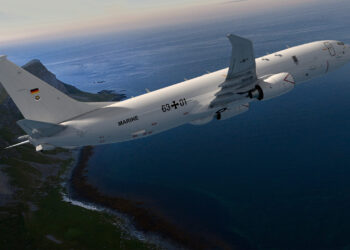US Navy,
MILWAUKEE: The Non-Line of Sight Launch System, being developed as part of the Army's Future Combat Systems, has been selected for use aboard the first of the U.S. Navy's Littoral Combat Ships, the USS Freedom.
USS Freedom was commissioned Nov. 8 during a ceremony in Milwaukee in which the ship's sponsor was Birgit Smith, the widow of Medal of Honor recipient Sgt. 1st Class Paul Ray Smith who was killed in Iraq with the 3rd Infantry Division.
The 378-foot Freedom — along with its sister ship, Independence, being built in Mobile, Ala. — represents a new class of ship for the Navy. These Littoral Combat Ships are designed to operate quickly in shallow water to counter threats in coastal regions, known as littoral areas, Navy officials said. They said the ships are specifically designed to counter mines, submarines and fast in-shore attack craft.
At the core of the new ship's capability to counter the coastal threats is the NLOS-Launch System, said Allan Ashley, the Navy liaison at the NLOS-LS Project Office. He said the launch system is scheduled to be evaluated aboard the new ship during tests set for early 2009.
NLOS-LS is being developed as part of the Army's FCS program to provide Soldiers with a rapidly deployable precision-fires delivery system. NLOS-LS is one of the first FCS components slated to be fielded, and is scheduled for delivery to Infantry brigade combat teams in 2011.
The NLOS-LS consists of a rapidly deployable networked container launch unit that houses 15 Precision Attack Missiles. Through the network, NLOS-LS can accept remote mission commands and conduct firing operations without the use of an attendant crew and attack a variety of targets. The unit is platform independent, officials said, and can quickly be installed on ground, manned and unmanned vehicles.
In the Navy application, four 15-missile NLOS-LS Container Launch Units are integrated together into one 60-missile mission module. Littoral Combat Ships will have weapons zones for up to three mission modules per ship. Therefore, depending on the operation, as many as 180 NLOS-LS Precision Attack Missiles may be available to the ship's captain to counter the threat of fast inshore attack craft.
Adapting the NLOS-LS for Navy use represents commitment among military services to ensure warfighting success by continuing to develop the joint warfighting force concept and building jointness in early, FCS officials said. They said in the case of NLOS-LS, this is being done at the system development and demonstration phase of acquisition.
“The US Navy is moving toward using a sea base approach — being able to deploy and control enough resources from an offshore location that we will not need to rely on a foreign country to establish a base of operations,” said Ashley, the NLOS-LS Navy Liaison.
Ashley said the NLOS-LS is critical to protecting the Littoral Combat Ship itself. He said it is also crucial to counter a range threats, including Marine landing operations, maritime special operations missions, and counter-piracy activities.
“In short, NLOS-LS not only protects our ship and sea base assets,” Ashley said, “but our Marines and Navy SEALS as they go ashore and conduct other operations in the littoral battlespace.”
Although the ship was formally commissioned this month, it was actually launched in September 2006. The first testing to determine the system's ability to track against fast in-shore attack craft was completed in August in the waters off Eglin Air Force Base on the Florida panhandle.
Prior to the ship's launching, Mrs. Smith participated in the “stepping of the mast” ceremony for the USS Freedom. She placed two coins at the base of the mast. The first was a coin minted from the metal of her and her husband's wedding bands. The second was Sgt. 1st Class Smith's Saint Christopher Medal.
During the commissioning of the USS Freedom Nov. 8 in Milwaukee's Veterans Park, in front of a crowd of 10,000 spectators, Birgit Smith was presented the first American flag that flew over the vessel. That same flag had also previously flown over Baghdad, where her husband was killed in action. Clutching the flag and flanked by the ship's leaders, Smith tearfully gave the order to the crew: “man our ship and bring her to life.”









